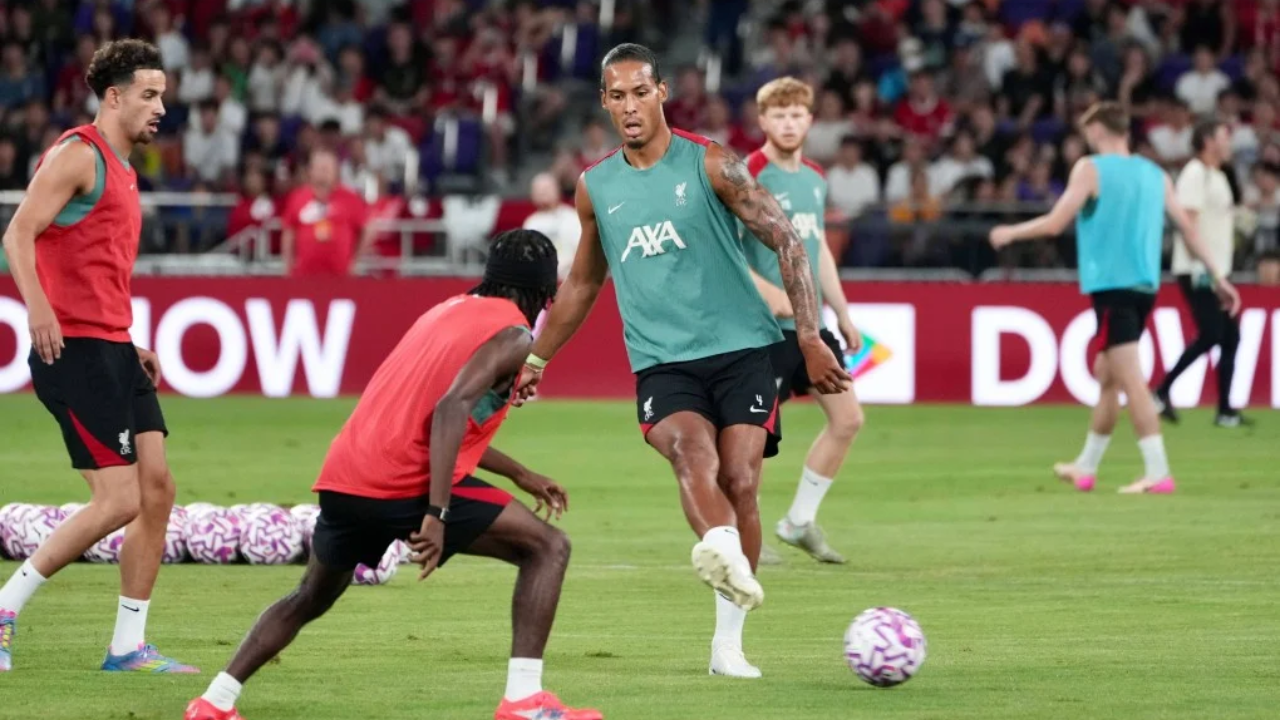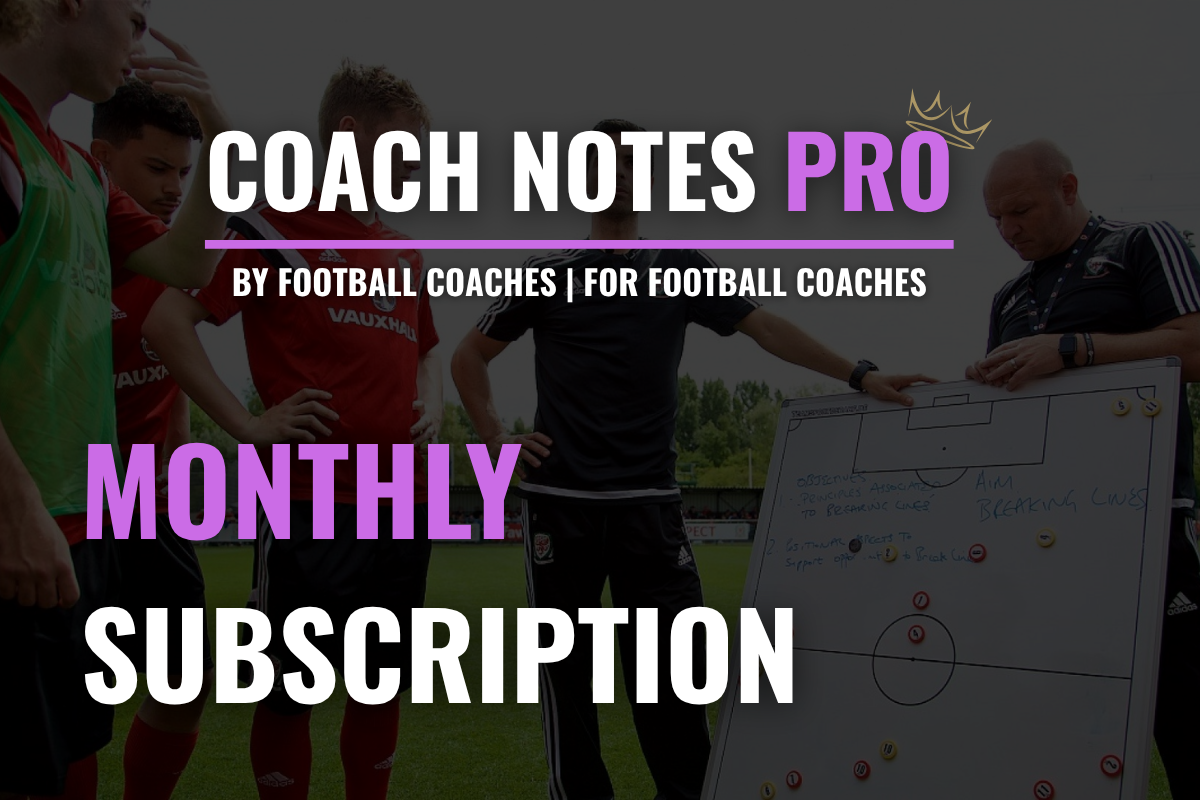
Centre-Back Specific Coaching
This section features 8 key areas essential to developing centre-backs, each with tailored coaching tips and position-specific drills. Every skill is broken down to help strikers make better decisions and execute with confidence in 1v1 situations.
1v1 Defending Coaching Tips
✅ Adopt a Low, Side-On Stance
Encourage centre backs to defend in a low, athletic position with knees bent, weight on the balls of the feet, and body slightly side-on. This posture allows for quick lateral movement and prevents being flat-footed, giving the defender better control when responding to changes in direction.
✅ Control the Space, Don’t Dive In
Centre backs must be patient and dictate where the attacker goes, using angles to guide them away from goal or into traffic. Overcommitting or diving into tackles risks being bypassed. Reinforce that the primary aim is to delay and contain — not always to win the ball immediately.
✅ Distance is Key: Close, But Not Too Close
Train defenders to engage at the right moment, typically about an arm’s length away. This allows them to apply pressure without being easily beaten. Defenders should adjust their distance based on the attacker’s speed, control, and direction of travel.
✅ Use the Body & Arms Legally
Instruct players to use shoulder-to-shoulder contact, arm positioning, and strength to unbalance attackers, particularly in shielding duels or when forcing them wide. Teach centre backs how to "feel" the attacker while staying within the laws of the game.
✅ Scan for Cover & Timing Support
When covering for a teammate in a 1v1 duel, centre backs must constantly scan the pitch to judge when to step in or stay compact. Reinforce communication and positioning as tools to manage multiple threats, especially when supporting a full-back or another centre back in wide areas.
Aerial Dominace Coaching Tips
✅ Timing of the Jump is Crucial
Teach centre backs to time their leap rather than jump as soon as the ball is played. The most dominant aerial defenders anticipate the ball’s flight early and jump at the peak moment for maximum height and control. Use heading drills where players are coached to attack the ball late and with power.
✅ Attack the Ball, Don’t Wait for It
In aerial duels, passive defenders are beaten. Centre backs should be trained to attack the ball proactively by stepping into the challenge early and asserting dominance. Reinforce aggressive intent in both defensive clearances and attacking headers.
✅ Use the Arms & Upper Body to Create Space
Teach players how to legally use arms for elevation and balance — spreading them slightly to keep opponents away while protecting their jump. Practice this in shadow duels and opposed aerial drills to build confidence and control under pressure.
✅ Scan Early and Adjust Body Shape
Before the ball is played, defenders must scan the area — where the attacker is, where teammates are, and where the ball is likely to land. This allows early positioning, better judgement of the flight, and body orientation that favours elevation and clearance.
✅ Head with Purpose – Not Just Contact
Winning the header is not enough — the direction and intent of the header matter. In defence, aim to clear away from central danger zones or head into wide areas. In attack, teach centre backs to direct headers downward toward goal or into dangerous second-ball areas.
Positioning Coaching Tips
✅ Maintain Line Integrity and Compactness
Centre backs should always be aware of the defensive line — stay connected horizontally with fellow defenders to avoid leaving gaps. A compact line reduces passing lanes and forces the opposition wide, where the threat is typically lower.
✅ Play Shoulder-to-Shoulder with Your Partner
When one centre back steps out to engage, the other must tuck in behind to cover. This covering defender should position themselves diagonally behind, ready to sweep up loose balls or delay an attacker if the first defender is bypassed. Train this rotation repeatedly in unit drills.
✅ Adjust Based on Ball and Opposition Movement
Defensive positioning is not static. Centre backs must constantly shift left and right depending on the ball's location, midfield protection, and the opposition’s runs. Reinforce the idea of “ball, man, space” — players should check all three before making a positional decision.
✅ Protect the Zone in Front of Goal
Centre backs must prioritise defending Zone 14 (the central area just outside the box) and the six-yard box. When out of possession, they should adopt positions that deny through balls into these areas and be ready to clear second balls. Good starting positions reduce emergency defending.
✅ Constant Scanning & Communication
Positional awareness is driven by scanning the pitch and communicating with teammates. Teach centre backs to check over their shoulders regularly and issue early, clear instructions (e.g. "cover", "drop", "step"). This builds cohesion and improves reactions to movement.
Building From The Back Coaching Tips
✅ Scan Before Receiving to Identify Options Early
Centre backs must scan the field before the ball arrives to assess the positioning of teammates, opponents, and available spaces. This pre-scan allows them to decide whether to play short, break a line, or recycle possession quickly under pressure.
✅ Create Passing Angles with Intelligent Movement
Encourage centre backs to adjust their positioning — dropping wide or stepping into space — to support the goalkeeper or pivot. Small movements can open clean angles and help stretch the opposition’s press, giving midfielders more time and space to receive.
✅ Stay Calm Under Pressure – Invite the Press
Train players to stay composed when pressed, using short, sharp passing with controlled body shape and balance. The goal is not just to evade pressure, but to manipulate it, drawing opponents in before playing around or through them.
✅ Use Both Feet and Vary the Tempo
Centre backs who can distribute comfortably with either foot can access more passing lanes and disguise their intentions. Teach players to vary tempo — mixing short, crisp passes with longer switches — to break pressing structures and shift defensive lines.
✅ Link Play Through Midfield or Full-Backs Efficiently
When building up, centre backs should look to find the pivot player (CDM) or step out themselves when space opens up. If the central option is marked, they must work the ball to a full-back or switch play quickly. Rehearse build-up patterns with clear triggers for progression.
Breaking Lines Coaching Tips
✅ Scan for Gaps Between Midfield Lines
Before receiving, centre backs must constantly scan for pockets of space between opposition midfielders. Teach them to identify moments when an opposing unit is disorganised or shifting, and look to exploit vertical channels with passes into feet.
✅ Use Disguise and Body Shape to Deceive Pressers
Encourage players to shape up as if to play wide, then deliver a disguised pass through the middle. Subtle shifts in body position or hip direction can help sell a pass and freeze pressing players, opening up central lanes for midfielders or attacking players.
✅ Play Firm, Driven Passes with Clarity
Breaking lines requires precision and speed — floaty or slow passes invite interceptions. Centre backs must be coached to play sharp, accurate passes into feet, often through tight windows. Use mannequins or defenders in training to simulate realistic line-breaking conditions.
✅ Understand When to Risk vs Recycle
Not every situation calls for a line-breaking pass. Teach defenders to weigh risk and reward, recognising when it’s safer to recycle possession or shift the point of attack, and when vertical penetration will unbalance the opposition.
✅ Coordinate with Midfield Movement
Effective line-breaking passes are timed with midfield movement. Centre backs and deep midfielders must be in sync — for example, when a midfielder drops or checks into a passing lane. Coach passing patterns and rotations that encourage dynamic movement off the ball.
Defending Inside The Box Coaching Tips
✅ Stay Goal-Side and Ball-Side at All Times
The number one priority is to position yourself between the attacker and the goal. Centre backs must constantly adjust their position in relation to both the ball and the closest opponent, particularly during crosses or cutbacks. Emphasise awareness and body orientation to stay “ball-side” and “goal-side”.
✅ Scan, Check Shoulder, and React Early
Box defending demands constant scanning — especially just before the cross is delivered. Players must check their shoulder to track runs and adjust their position before the ball is played, rather than reacting too late.
✅ Attack the Ball, Don’t Wait for It
Centre backs must be aggressive in the box — particularly when defending crosses. Coach them to step forward and clear with authority, using the head or foot depending on the height. Waiting for the ball to arrive often leads to hesitation and danger.
✅ Compactness and Covering Angles
In moments when the defence drops deep, centre backs should remain compact, closing gaps between teammates to prevent split passes or dangerous cutbacks. Blocking angles to goal is critical — especially when dealing with second balls or rebounds.
✅ Low, Balanced Body Shape for Blocks
To make effective blocks or last-ditch tackles, centre backs need a low centre of gravity, bent knees, and weight on the balls of their feet. This allows them to react to quick shots or changes in direction with speed and balance.
Defending Transitions Coaching Tips
✅ “First Five Seconds” Mentality
Train centre backs to develop a fast reaction mindset upon losing possession. The first five seconds after transition are critical — defenders should either delay the counter, drop to protect space, or engage to recover depending on the situation. Decision-making must be instant.
✅ Drop Quickly to Protect Central Space
Centre backs should prioritise protecting the space behind them when the ball is lost. Immediate recovery runs into central positions help prevent direct attacks through the middle. Encourage defenders to recover goal-side and reset defensive structure early.
✅ Communicate and Organise On the Move
In transition moments, roles change rapidly. Centre backs must become vocal leaders, quickly instructing teammates to cover wide areas, mark central runners, or delay the opponent. Clear, early communication limits chaos and prevents disorganisation.
✅ Recognise Triggers and Counter Patterns
Help centre backs anticipate when transitions are likely, such as after risky forward passes or full-backs advancing. Train them to recognise counter-attack cues and begin adjusting their positioning before the ball is lost.
✅ Delay, Don’t Dive In
In moments of temporary overload, defenders should prioritise delaying the attacker rather than diving in. Slowing down the opposition gives time for teammates to recover and helps prevent getting beaten in isolation.
Defensive Shape Coaching Tips
✅ Constantly Adjust Line Depth Based on Pressure
Centre backs must read the pressure on the ball. If the ball is pressed high, the back line can squeeze up. If pressure is broken, they must drop quickly to protect space behind. Defensive shape is a fluid line, not a fixed position — awareness and adaptability are key.
✅ Stay Compact Horizontally and Vertically
A well-structured block must be both narrow and tight between lines. Centre backs should maintain short distances with full-backs and the holding midfielder, minimising gaps that attackers can exploit. Train communication and awareness of lateral spacing at all times.
✅ Move as a Unit – Stay Connected
Defensive shape must shift collectively — whether stepping, sliding, or dropping. If one defender moves independently (e.g., steps out to press without cover), it creates gaps. Centre backs should lead the line by organising synchronised movements with their partners.
✅ Avoid Ball-Watching – Prioritise Player & Space
Centre backs must resist the urge to over-focus on the ball. Instead, they must track off-the-ball movement, stay in position, and be aware of runs behind or into gaps. Good shape requires balancing positional discipline with anticipation.
✅ Communication in Blocks
Whether defending in a mid-block or deep block, roles must be clearly communicated — who steps, who covers, and who tracks runners. Centre backs must act as on-field coordinators, ensuring the line stays intact and reacts in unison.

































